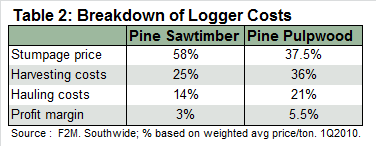
The cost structure of a logging business provides insight into the differences between stumpage prices paid to timberland owners and delivered prices paid by the mill.
Delivered price can be divided into four categories: stumpage price, harvesting costs (Table 1), trucking or hauling costs, and logger profit. Table 2 shows these components of delivered price broken down as a percentage of total price.
Across the board, these numbers show the majority of the price paid by the mill goes back to the timberland owner. This number is highest for sawtimber, reflecting the time and money landowners invest to produce larger trees.
The dollar amounts for both harvesting and hauling are roughly equivalent, as a truckload of sawtimber and a truckload of pulpwood weigh approximately the same and take about the same amount of effort to cut and load onto the truck. The higher percentages for pulpwood in these two categories are primarily a reflection of the lower total price a mill pays for pulpwood.

Profit Margins
Profit margins for the supplier average 3 to 5.5 percent. In general, a profit margin reflects the amount of value added to the product during processing and the amount of risk associated with the endeavor.
While loggers do not technically add value to the timber they process and deliver, they do turn trees into logs. Without them, no wood would be available to the mills that do add value by converting timber to lumber, paper, or furniture.

Risks
The risks of working in the logging industry are significant. In 2012, the average worker fatality rate was 3.2 deaths per 100,000 full-time employees. For loggers, that number was 128 per 100,000, making it the most dangerous occupation.[1]
The financial risks for the owner are also high. On one hand, these companies have to invest in several pieces of heavy equipment, ranging in cost from $250,000 to $1 million. On the other hand, the source of income is far from stable. The ability to harvest, get paid, and make equipment payments depends upon multiple factors (natural disasters, wet weather, tract availability, and consumer/mill demand) outside the control of loggers.
In the current economy, the weight of these costs has driven many loggers out of business. Estimates of companies no longer operating range from 25 to 50 percent. As a result, landowners may have difficulties finding reliable loggers when they are ready to sell.
Additionally, because they are leery of taking out additional equipment loans, many loggers cannot take advantage of new opportunities like the emerging market for harvest residues for energy production. When loggers cannot collect or deliver this material, landowners miss out on an additional source of revenue as well.
Comments
07-02-2014
Thank you very much for this, and the other, valuable information contained in your newletter.


 Suz-Anne Kinney
Suz-Anne Kinney


